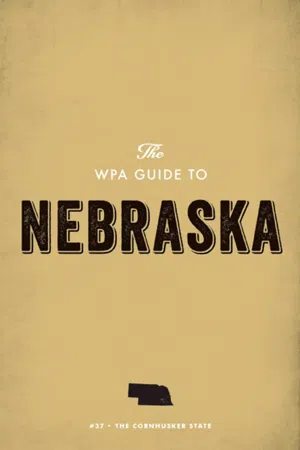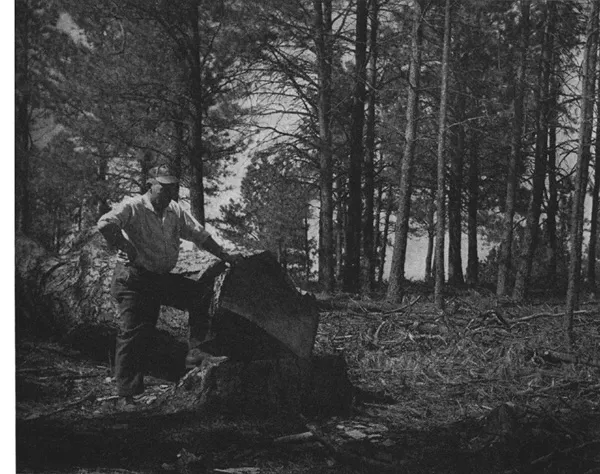![]()
PART III
Tours
![]()
Tour 1
(Sioux City, Iowa)—South Sioux City—Tekamah—Omaha—Nebraska City—Falls City—(Hiawatha, Kans.); US 73-77, 73E, 73-75, 73. Missouri River at South Sioux City to Kansas Line, 205 m.
Between Dakota City and Winnebago, the Chicago, Burlington & Quincy R. R. parallels the route; between Blair and Omaha, the Chicago, St. Paul, Minneapolis & Omaha Ry.; between Omaha and Falls City, the Missouri Pacific R. R. The Mid Continental Air Lines fly this route, but stop only in Omaha. Bus service throughout. Hard-surfaced roadbed except for two stretches of gravel (between Homer and Tekamah, and between a point 5 miles south of Auburn and the junction with State 4).
Accommodations available at short intervals; hotels chiefly in cities.
Between the northeastern and the southeastern corners of Nebraska, US 73 parallels the general course of the Missouri River, here a wide, winding and rather shallow stream, lined with high wooded bluffs on the Nebraska side. In spring and summer the rolling waters of the Big Muddy, rich chocolate in consistency and hue, set off sharply the green of forests, fields and orchards along its banks.
Today traffic does not flow up and down the Missouri, but across it on the great east-west railways and highways that slowly but completely re-orientated the life and activities of the Trans-Mississippi West. But before the railroads and highways were built, the Missouri was a great artery of travel and commerce.
Up the Missouri, the gateway to the Pacific Northwest, came Lewis and Clark in 1804 on their momentous exploration of the newly-purchased Louisiana Territory and of Oregon. Plodding slowly up the western bank, with their small fleet following them, they camped often in what is now Nebraska. Fur traders and trappers followed them—among others, Manuel Lisa, the Astorians, William Ashley, Jedediah Smith, Andrew Henry, Thomas (“Cut Hand”) Fitzpatrick. In time many trading posts were established along the river in Nebraska. Down the river each spring came the traders in their bullboats, floating their peltries to the market in St. Louis.
The Missouri also played a part in the legendary career of Mike Fink, or “Phink,” as Mike himself liked to spell it to prove his education. Many stories are told of the prowess of that “ring-tailed-roarer,” hero of the river boatmen, the Paul Bunyan of his field. Mike and his friend Carpenter, a trapper, often amused themselves by shooting tin cups filled with whiskey from each other’s heads at a distance of 70 yards!—just to demonstrate their skill and mutual confidence, they said. Seeing a Negro boy lounging on the river bank one day, Mike felt his sensibilities outraged by the size and shape of the boy’s feet. Mike casually shouldered his rifle and shot off the Negro’s heel. He was tried and convicted in spite of his plea that he was merely trying to do a service by modeling the boy’s foot to fit a boot such as gentlemen wore.
Along the highway, which is never more than a few miles from the river, the landscape is that of the typical eastern Nebraska prairie. The route passes through river towns, quiet country villages, Indian reservations, several small bustling cities; the orchard district of the State.
Section a. MISSOURI RIVER to OMAHA, 99.2 m. US 73-77, US 73 E, US 73
The highway crosses the Missouri River, 0 m., on a toll bridge (20¢ for car and driver; 5¢ each passenger).
SOUTH SIOUX CITY, 1 m. (1,106 alt., 3,927 pop.) (see Tour 7), is at the junction of US 73 and US 77, which are united between this point and 19.9 m.
At 2.5 m. is the junction (R) with US 20 (see Tour 7).
DAKOTA CITY, 5.2 m. (1,102 alt., 417 pop.), a quiet country town, has one of the widest main streets (300 feet) in Nebraska. The street is, in fact, three streets; a dirt road lies on each side of the paved strip through the center of the town. Dakota City was surveyed and platted in 1855–56, and incorporated two years later.
The site of Dakota City was visited by the Lewis and Clark expedition, which reached the mouth of Omaha Creek in Dakota County on August 16, 1804.
When a branch of the General Land Office was established in Dakota City in 1857, the town aspired to metropolitan status and constructed a three-story hotel with a two-story wing at a cost of $16,000 in gold. The United States District Court was held here twice a year, adding to the town’s official importance. But when Nebraska was admitted as a State, there was a decline. The court no longer met here, and the Land Office was removed to Niobrara. Even the hotel was torn down.
The Dakota City LUTHERAN CHURCH (R), a white frame building with a belfry and green shutters, was the first Lutheran church in Nebraska (1860). It was built at a cost of $2,000, spent almost entirely for material, as labor was donated. For a number of years it housed the Territorial court.
The Yellow Dakota County COURTHOUSE (R), built in 1870 and still in use, stands just off the highway among trees.
During the early years river traffic attracted many types of people to the town. Father Martin, who edited the Dakota City Argus when not doing missionary work among the whites in South Dakota, wrote fiction about many characters in the town. His serial The Conflict: Love or Money? included, in only slightly changed form, the names of townspeople he disliked. Atlee Hart, his rival editor, became Atlee Heartless. The story ran for almost 10 years. There were no libel laws, and the editor died of natural causes.
Citizens tell of the day when the steamer Nugget sank after hitting a snag in the Missouri River at Dakota City. It was carrying a cargo of whisky, which the men and boys of the town promptly salvaged and drank.
NEBRASKA’S LAST VIRGIN TIMBER
HOMER, 13 m. (452 pop.), a small farming and trading post, lies in a valley (R), with a T-shaped main street.
1. Right from Homer on a country road to the SITE OF AN OMAHA INDIAN VILLAGE, 0.5 m., known as the Large Village. Built in the eighteenth century, on the side of a rather steep hill now devoted to farming, the village had been burned before the Lewis and Clark expedition reached the site in 1804. In their journals, however, the village is described as having had 300 huts, abandoned after smallpox had destroyed 400 men and many women and children. Numerous graves are on the site.
2. Left from Homer on a graded dirt road that runs into heavily timbered country to LAND’S END, 6 m., an abrupt descent of 500 feet from the top of the bluff to the river below. At this point the Indians prayed to their Great Spirit for a bountiful harvest, and here they held a sacrificial dance. After feasting all day, six of the strongest and bravest men began an endurance dance at sundown. To the beating of the tom-toms, they danced without food or drink until one of them fell from exhaustion and tumbled over the embankment into the Missouri.
South of Homer the country becomes hilly, and the highway runs along the western boundary of the proposed LEWIS AND CLARK NATIONAL PARK AND BIRD SANCTUARY (L), a heavily wooded region extending 25 miles along the Missouri bluffs and covering about 30,000 acres.
Along the river are steep bluffs, extended views, and wooded hills. Westward the country is rough and primitive, marked by small lakes, creeks, swamps, and thick undergrowth, leveling off eventually into rich farming lands. The proposed park would include a stretch of this broken country, which is part of the Omaha and Winnebago Indian Reservations (see below); a strip on the Iowa side of the Missouri; and a part of Dakota County, Nebr., which includes a camp site of Lewis and Clark. The Indians favor the proposal, and it is hoped that the region will eventually be restocked with game animals and other wild life.
WINNEBAGO, 19.9 m. (653 pop.), is a small Indian town. Lined along its graveled business street, which lies on a slant between two high hills, are the usual business establishments and churches. The old, weather-beaten, one-story buildings are white frame for the most part, although some are red and still others are gray and yellow stucco.
Winnebago (Ind., the disfavored ones) lies within the Winnebago Indian Reservation (see below), but the town proper is not included in the 32,250 acres that make up the reservation. On a tree-covered hill in the northwestern part of Winnebago, 0.2 miles right from the highway, is the white-frame ROMAN CATHOLIC MISSION AND CHURCH, its white crosses jutting high among the trees. A parochial school was established here in 1910 by Mother Catherine Drexel of Philadelphia. About 50 Indian children board here during the school term.
Nearby and farther downhill is the public WINNEBAGO HIGH SCHOOL, built of red-and-blue brick, and attended by both Indian and white children.
On another and higher hill, two blocks left from the main s...




